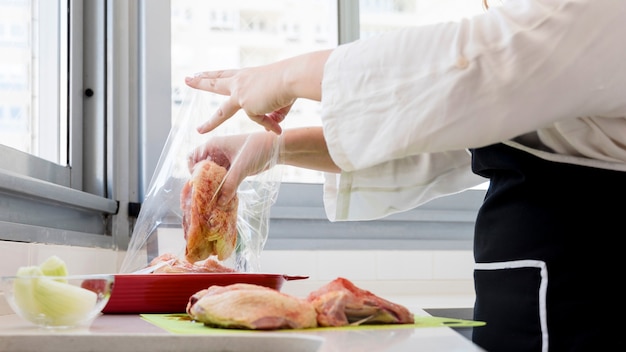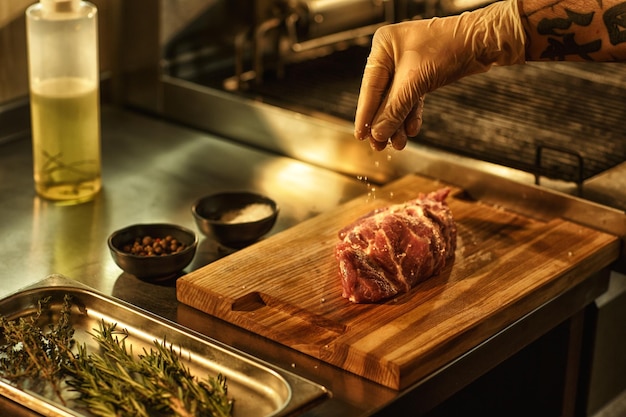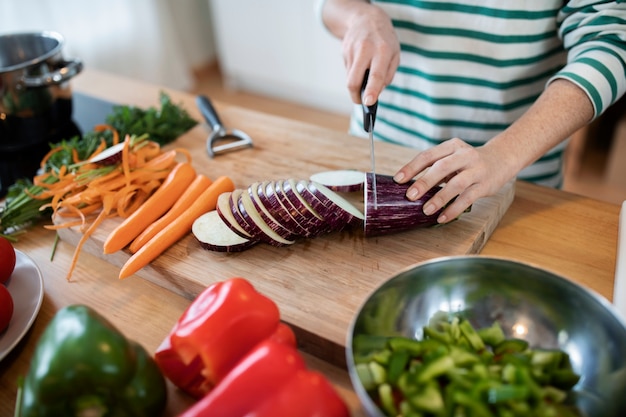Let's talk about pork chops, one of my all-time favourite meals! But you know what's crucial when cooking pork? Getting the internal temperature just right. No one wants a dodgy tummy, so we're going to dive into the world of pork chop safety and ensure you enjoy your meal with peace of mind.
Part 1: The Basics of Pork Chop Safety

Think back to the days when we used to cook pork to a much higher temperature, all because of worries about trichinosis. Well, thanks to modern farming practices, that risk is pretty low nowadays. But that doesn't mean we can just toss a pork chop on the grill and call it a day. We still need to ensure it's cooked thoroughly to eliminate any potential bacteria lurking around.
Understanding the Risks: foodborne illnesses
While trichinosis is less of a concern, other foodborne illnesses like salmonella and E. coli can still be present in undercooked pork. These bacteria can cause a range of unpleasant symptoms, from mild nausea and diarrhoea to more severe issues like fever, dehydration, and even hospitalization.
The Importance of Internal Temperature: Our Key to Safety
The best way to ensure your pork chops are safe to eat is to check their internal temperature. That's where a good old-fashioned meat thermometer comes in handy. Don't rely on just looking at the colour – it can be deceptive!
Part 2: What's the safe internal temperature for Pork Chops?

The Food Standards Agency recommends that pork chops should be cooked to an internal temperature of at least 71°C (160°F). This is the temperature that guarantees any harmful bacteria are destroyed.
Why This Temperature? The Science Behind Safety
Many factors contribute to this recommended temperature. The most important is the death of bacteria. Bacteria like salmonella and E. coli have a specific temperature range they can survive in. By reaching 71°C (160°F), we ensure these bacteria are eliminated, making the pork safe to consume.
Part 3: How to Check the Internal Temperature

Let's get practical. You'll need a meat thermometer. I prefer the instant-read ones because they provide a quick and accurate reading, but any type will do. Here's how to use it:
Step-by-Step Instructions for Accurate Readings
1. Insert the thermometer: Make sure the probe goes deep into the thickest part of the pork chop, avoiding bone. This ensures you're measuring the core temperature, not just the surface.
2. Wait for the reading: Let the thermometer settle for a few seconds to get an accurate reading. Don't rush!
3. Check the temperature: Compare the reading to the safe internal temperature of 71°C (160°F). If it's below, cook the chop further.
Using a digital meat thermometer: The Modern Way
Digital meat thermometers are fantastic. They often have a timer and a magnetic base for easy use. Some even have alerts that signal when the desired temperature is reached, perfect for hands-free cooking!
Part 4: Different Cooking Methods for Pork Chops
Now that we've tackled the safety aspect, let's explore some delicious ways to cook pork chops!
The Grill: A Classic Option for Summer
Ah, the grill! It's a classic for pork chops. Just make sure your grill is nice and hot before you throw them on. Don't overcrowd the grill – give them space to cook evenly. Flip them halfway through to ensure they cook evenly.
The Oven: A Reliable Option
If you're not a grill master, the oven is a good backup. Preheat your oven to 190°C (375°F) and place the pork chops on a baking sheet. You can even baste them with a bit of oil and seasoning for extra flavour.
The Pan: For a Quick and Delicious Meal
A good pan-fried pork chop is a real treat. Heat some oil in a pan over medium-high heat, then sear the pork chops on each side for about 3 minutes. Reduce the heat and cook for a further 5-7 minutes, or until the internal temperature reaches 71°C (160°F).
Part 5: How to Tell if Your Pork Chop is Cooked Through
There are a few visual cues to help you judge if your pork chop is cooked through, even before you use the thermometer.
Colour Changes: A Sign of Thorough Cooking
When the pork chop is cooked, it will turn a more opaque white, with a slightly golden brown crust. It won't be pink anymore. This change is due to the proteins in the meat coagulating as they cook, resulting in a more opaque appearance.
Texture Changes: From Soft to Firm
A cooked pork chop will be firm to the touch, not squishy or soft. This firmness indicates that the internal temperature has reached the safe range and the proteins have fully cooked. The juices should run clear, not pink. Pink juices indicate that the pork chop is still raw.
Part 6: What to Do if Your Pork Chop is Undercooked
So you've taken the temperature and it's not quite there yet? Don't worry, it's not a complete disaster.
Finish Cooking: Don't Give Up
If you've been cooking the pork chop on the grill, just move it to a slightly cooler part of the grill and let it cook a little longer. Or you can move it to the oven to finish.
Don't Overcook! The Importance of Tenderness
Remember, we want the pork chop cooked through, not dried out! If you overcook it, it will become tough and chewy.
Part 7: Resting the Pork Chop: Maximizing Juiciness
After the pork chop has reached the desired temperature, let it rest for a few minutes before slicing and serving. This allows the juices to redistribute, making it more tender and juicy. The resting time also allows the pork chop to continue cooking slightly, ensuring the internal temperature is consistent throughout.
Part 8: Delicious pork chop recipes
Now, let's get into some tasty recipes! Here are a few of my favourites:
Classic pan-seared pork chops with Garlic and Rosemary: Simple and Delicious
Ingredients:
4 thick-cut pork chops
1 tablespoon olive oil
2 cloves garlic, minced
1 tablespoon fresh rosemary, chopped
Salt and pepper to taste
Instructions:
1. Heat the olive oil in a pan over medium-high heat.
2. Season the pork chops with salt and pepper.
3. Sear the pork chops in the pan for 3 minutes per side. This creates a nice crispy crust.
4. Add the garlic and rosemary to the pan and cook for 1 minute. Their aroma will infuse the pork.
5. Reduce the heat to medium and cook the pork chops for a further 5-7 minutes, or until the internal temperature reaches 71°C (160°F).
6. Let the pork chops rest for a few minutes before slicing and serving.
Honey Garlic Glazed Pork Chops: Sweet and Savoury
Ingredients:
4 thick-cut pork chops
1 tablespoon olive oil
1/4 cup honey
1/4 cup soy sauce
2 tablespoons rice vinegar
1 clove garlic, minced
1 teaspoon ginger, minced
Instructions:
1. Preheat the oven to 190°C (375°F).
2. In a small bowl, whisk together the honey, soy sauce, rice vinegar, garlic, and ginger. This creates a delicious and sticky glaze.
3. Heat the olive oil in a large oven-safe skillet over medium-high heat.
4. Sear the pork chops in the skillet for 3 minutes per side. This gives them a nice sear.
5. Pour the honey garlic glaze over the pork chops.
6. Transfer the skillet to the oven and bake for 15-20 minutes, or until the internal temperature reaches 71°C (160°F).
7. Let the pork chops rest for a few minutes before serving.
grilled pork chops with Mango Salsa: A Summery Treat
Ingredients:
4 thick-cut pork chops
1 tablespoon olive oil
Salt and pepper to taste
1 mango, diced
1/2 red onion, diced
1/4 cup chopped cilantro
2 tablespoons lime juice
1 tablespoon olive oil
Instructions:
1. Preheat the grill to medium-high heat.
2. Brush the pork chops with olive oil and season with salt and pepper.
3. Grill the pork chops for 4-5 minutes per side, or until the internal temperature reaches 71°C (160°F).
4. While the pork chops are grilling, prepare the mango salsa. Combine the mango, red onion, cilantro, lime juice, and olive oil in a bowl and toss to combine.
5. Let the pork chops rest for a few minutes before serving. Serve with the mango salsa on top.
Part 9: FAQs
Now for some questions you might have about cooking pork chops:
1. What happens if I eat undercooked pork?
You could get food poisoning. The symptoms can range from mild nausea and diarrhoea to more severe things like fever and dehydration. It's not worth the risk!
2. Can I use a meat thermometer to check the internal temperature of other meats?
Absolutely! You can use a meat thermometer for all sorts of meat, including chicken, beef, lamb, and fish. Just make sure you check the recommended internal temperature for each type of meat.
3. How do I know if my meat thermometer is accurate?
A good idea is to check it against a thermometer that's known to be accurate, like one you use for baking. If there's a significant difference, you might need to replace it.
4. How long can I safely keep cooked pork chops in the fridge?
It's best to eat cooked pork chops within 3-4 days. After that, the quality will start to decline, and the risk of bacteria growth increases.
5. What happens if I freeze cooked pork chops?
You can freeze cooked pork chops for up to 3 months, but the texture might change a bit when you thaw them. It's best to freeze them in airtight containers or freezer-safe bags.
Part 10: Conclusion
So there you have it! Now you know everything you need to know about cooking pork chops safely and deliciously. Remember, checking the internal temperature is key to ensuring that your pork chops are cooked through and safe to eat. Don't be afraid to experiment with different recipes and cooking methods, and enjoy your delicious and safe pork chops!
Everyone is watching

Prime Rib Roast Cooking Time Chart: Per Pound Guide
Cooking TipsPrime rib roast. Just the name conjures images of lavish dinners, crackling fires, and hearty laughter. It’s ...

How Long to Bake Potatoes in the Oven (Perfect Every Time)
Cooking TipsBaked potatoes are a staple in my kitchen. They're incredibly versatile, delicious, and surprisingly easy to m...

Perfect Rice Every Time: The Ultimate Guide to Cooking Rice
Cooking TipsAs a self-proclaimed foodie, I've always been a bit obsessed with rice. It's the foundation of countless cuisi...

The Ultimate Guide to Cooking Asparagus: Tips, Techniques, and Recipes
Cooking TipsAsparagus. The mere mention of this spring delicacy conjures up images of vibrant green spears, crisp and burs...

Ultimate Guide to Cooking the Perfect Thanksgiving Turkey
Cooking TipsThanksgiving. Just the word conjures up images of overflowing tables laden with delicious food, the scent of r...
